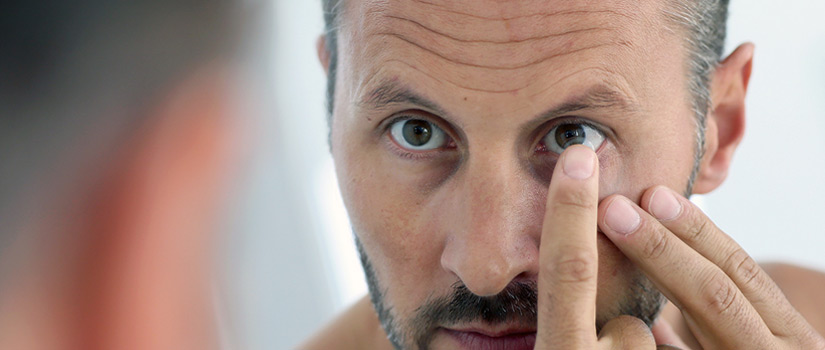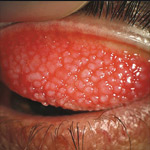Overview
“Giant papillary” refers to large bumps that form under your eyelid. GPC is an eye irritation, not an infection.
This is condition that often occurs with the over-wearing of contact lenses, and, or an allergic reaction to the lenses themselves, or a reaction to a particular brand of lens cleaner or storage solution. It can also result from an allergic reaction to some types of makeup or skin products. Other common causes are a reaction to the pillow that one sleeps on, or even the laundry washing soap or fabric softener you are using. It is essentially an allergic reaction of the delicate soft tissue on the insides of the eyelids. The clue that GPC is evident might not be obvious to the wearer, but a regular visit and examination by your eyecare professional will detect the early onset of GPC.
Many variables can affect the onset and severity of the presenting signs and symptoms. Nonionic, high-water-content soft contact lenses tend to produce less severe signs and symptoms than ionic, low-water-content soft contact lenses. Enzymatic treatment appears to lessen the severity of signs and symptoms. The association of an allergy appears to play a role in the onset of the severity of the signs and symptoms but does not appear to affect the final ability of the individual to wear contact lenses.
A subtle hint for the wearer that there might be early onset of GPC is that your contact lenses seem to move a lot in your eye, and “sticking” to your upper eyelid. To isolate the offending substance or circumstance can be tedious, but one can start by switching to daily disposable lenses where available. Careful monitoring of the progression by your eyecare professional is essential. In some cases, rigid gas permeable (hard lenses) are an option to slow down the progression. If, in extreme cases, the progression is not contained, one may have to refrain from wearing contact lenses for a long period of time, or altogether.
Signs and Symptoms
Signs and symptoms of GPC include
- Itching and redness of the eye(s), burning sensation.
- Eye pain and inflammation of the eyelid; with gritty feeling of sand-like particle inside the eye.
- Regular discharge of watery mucus from the eyes, blurred vision.
- Contact lens users may often find their lens uncomfortable, slipping out of position (as they blink), sticking to the inside of the eyelid, or requiring frequent cleaning.
Giant papillary conjunctivitis is a common complication of contact lens wear. It has also been called contact lens–induced papillary conjunctivitis (CLPC). Prior to the popularization of hydrogel (soft) contact lenses over the past 4 decades, such reactions were primarily seen as immunoglobulin E (IgE)–mediated ocular allergies. Giant papillary conjunctivitis symptoms and signs, such as papillary changes in the tarsal conjunctiva, have been associated with the use of all types of contact lenses (eg, rigid, hydrogel, silicone hydrogel, piggyback, scleral, prosthetic).
Similar reactions have been noted with ocular prostheses, extruding scleral buckles, exposed ocular sutures, and even elevated corneal scars. The initially small papillae eventually coalesce with expanding internal collections of inflammatory cells. When the lesions reach a diameter of more than 0.3 mm, often approaching or exceeding 1 mm, the condition is referred to as giant papillary conjunctivitis.
Causes and Risks
Giant Papillary Conjunctivitis is essentially an allergic inflammatory response caused by the constant friction between the conjunctiva and other physical device/implant/suture present in the eye against which it rubs, as the eyes blink regularly or close, for a prolonged period. This is described as a kind of mechanical micro-trauma
Some typical causes also include:
- A chronic use of contact lens (of any type) is the most frequent causal factor for GPC.
- Sometimes the material of the contact lens (or the chemical it is stored in), or certain deposits that form over the contact lens, cause the build-up of certain proteins in the eye. Such situations may also bring about some changes in the soft tissue of the eye, which triggers an allergic reaction.
- When the allergen comes into contact with the conjunctiva and mucus membranes lining the eyes, the body releases histamine (an organic chemical) triggering the allergy symptoms. This may be due to an extremely sensitive body immune system.
- The presence of other diseases or disorders (like asthma, eczema, hay fever) may initiate Giant Papillary Conjunctivitis.
- Lack of proper cleaning of contact lenses, using worn-out lenses, lens with rough edges, wearing lenses while sleeping, using unapproved (or stale) solutions to store lenses, are all factors that encourage the formation of papillae.
All contact lens wearers are potential GPC patients, but you are at greater risk of getting this condition if you:
- Wear reusable soft contact lens.
- Wear contact lens for prolonged periods.
- Sleep in contact lens (even if they are approved for night wear).
- Don’t clean your contact lens properly.
- Use old contact lens solutions.
- Have asthma.
- Have chronic allergies or hay fever.
- Have a family history of allergies.
It is important to note that having a risk factor does not mean that one will get the condition. A risk factor increases ones chances of getting a condition compared to an individual without the risk factors.
Because of the high prevalence of giant papillary conjunctivitis in contact lens wearers, every patient who wears contact lenses should be considered as a potential patient with giant papillary conjunctivitis. GPC is however, not contagious.
Stats and Incidence
Giant papillary conjunctivitis is a syndrome found most frequently as a complication of contact lenses wear.
Using multiple treatment options, such as changing the polymer to a glyceryl methyl methacrylate or a rigid lens, or utilizing a soft lens on a frequent-replacement basis, can result in a success rate of over 90%.
In individuals who still have a return of symptoms, the use of topical mast cell stabilizers or a nonsteroidal anti-inflammatory drug as an adjunctive therapy offers the added possibility of keeping these patients in contact lenses.
Treatment
Management measures for Giant Papillary Conjunctivitis include controlling factors responsible for an allergic trigger, treating the symptoms, and moderating the body immune response system.
They are as follows:
- GPC is primarily managed by avoiding contact lens wear for several weeks, or as required (and using spectacles instead).
- Correction of other factors such as implants or exposed sutures, are considered; if they are the causative factors of GPC.
- Application of cold compress can help reduce discomfort.
- If necessary, medications such as oral antihistamines and mast cell stabilizers (a non-steroid drug), may be used depending on the type of symptoms.
- Other drugs to provide relief from symptoms are corticosteroids (prescribed in severe cases only),
- lubricating or anti-inflammatory eye-drops, and ointments.
- Immunotherapy (allergy shots) is used to desensitize the body and prevent it from overreacting to such external triggers. This method is usually considered, in case of a severe allergic attack that does not respond well to treatment, or when other medical disorders are also present.
- Proper choice and care of contact lenses (including ensuring proper hygiene), frequent changing of the lens set (using daily or weekly disposable lenses), are steps that can help prevent recurrence of the condition.


